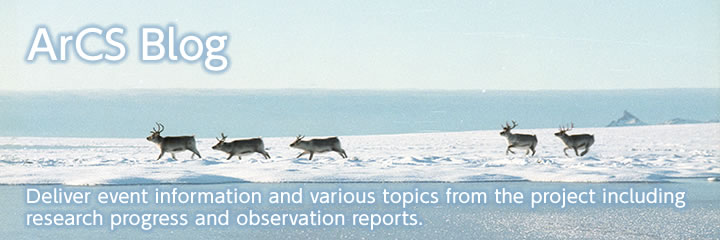In this ArCS research program, I stayed at Bylot Island and Pond Inlet, located at Nunavut, Canada. Bylot Island is a National Park (Sirmilik national park) which is strictly protected by the Canadian government. To enter this island, we need to take an orientation session for the permission at Parks Canada and arrange the helicopter by our self. This strict management contributes to the maintenance of beautiful natural ecosystems. Pond Inlet is an Inuit village at the north Baffin. Many researchers use this village as a logistics base for research in Bylot during summer.

After the field activities at Qaanaaq Ice Cap and a workshop with residents of Qaanaaq Village, a 5-day ocean measurement campaign was performed in Inglefield Fjord from August 13.
Japan joined 9 other countries and 3 indigenous people’s organizations in a meeting of the Conservation of Arctic Flora and Fauna, the biodiversity working group of the Arctic Council, held in Dutch Harbor/Unalaska September 4-5.
We joined the East GRIP field campaign in 2018. East GRIP is an international project for ice-sheet core drilling in order to clarify the changing of Greenland ice-sheet and climate. Eight researchers and engineers participated in 2018 East GRIP campaign from Japan (including 1 Spanish researcher).
As a part of ‘theme 6’ ecosystem and biodiversity research program, ArCS researchers studied seabirds breeding on St Lawrence Island, Northern Bering Sea. This season is the third year of our fieldwork, which started in 2016. Researchers from NIPR, Hokkaido University, and University of Alaska Fairbanks worked together with native guides from St. Lawrence Island, from mid-July to the end of August. I traveled to join the fieldwork from 31 July – 18 August 2018.
In order to estimate an influence of ocean acidification in sub sea-surface waters to planktons bearing calcium carbonate shell, the subgroup of “theme 4” in ArCS project has conducted fixed point observation using bottom-tethered mooring in Pacific side of the Arctic Ocean. In this August, I joined the Arctic Ocean cruise (Leg 1) of ice breaker ARAON of Korean Polar Research Institute (KOPRI) to deploy our mooring, which had composed of sediment traps taking particles in water and some sensors to record hydrographic parameters such as pH, temperature, salinity, and ice thickness for a year.
I am doing research in Novosibirsk State University (Institute of Archaeology and Ethnography) from February 2018. Let me introduce my life and my research briefly.
The Ice Base Cape Baranova research station is located in Bolshevik Island of the Severnaya Zemlya Archipelago (79°18'N 101°48'E). The research station, operated by Arctic and Antarctic Research Institute (AARI), opened in 1980’s and reopened in 2013 after an almost 10-year temporal close. National Institute of Polar Research and the University of Tokyo had just started a joint observation research with AARI at the research station when I visited the Cape Baranova in November 2017.
We held a workshop with the residents of the Qaanaaq Village on 29th July. This workshop is to present our research activities to the local people, and to exchange information of environmental change and its impact on the society. This event has been organized every summer since 2016 to build a collaborative relationship with the locals. Researchers from Hokkaido University, Kyoto University and Calgary University participated the workshop this year. We introduced our research activities on ice caps, glaciers, the ocean and landslide, which were followed by questions from the audience. 20–30 people attended and listened to our presentations carefully.
The East Greenland Ice-core Project (EGRIP) aims to retrieve ice cores by drilling through the Northeast Greenland Ice Stream (NEGIS). Ice streams greatly affect draining a significant fraction of the ice from the Greenland Ice Sheet, and we hope to obtain new and fundamental information on ice stream dynamics through the project, thereby improving the understanding of how ice streams will contribute to future sea-level change.




